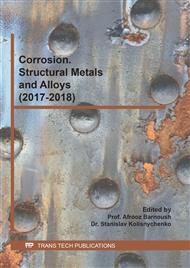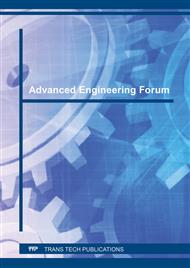[1]
Cobb, H.M., (2010), the History of Stainless Steel, ASM International, Materials Park, USA.
Google Scholar
[2]
Turnbull A, Ryan M, Willetts A, Zhou SQ (2003), Corrosion and electrochemical behaviour of 316L stainless steel in acetic acid solutions, Corrosion Science, 45, 1051–1072.
DOI: 10.1016/s0010-938x(02)00149-x
Google Scholar
[3]
J. M. Zhao, Y. Zuo, The effects of molybdate and dichromate anions on pit propagation of mild steel in bicarbanate solution containing Cl-, Corros. Sci., 44, 2002, 2119-2130.
DOI: 10.1016/s0010-938x(02)00017-3
Google Scholar
[4]
H. -Y. Ha, T. -H. Lee, S. -J. Kim, Role of nitrogen in the active–passive transition behavior of binary Fe–Cr alloy system, Electrochim. Acta, 80, 2012, 432-439.
DOI: 10.1016/j.electacta.2012.07.056
Google Scholar
[5]
A.I. Almarshad, D. Jamal, Electrochemical investigations of pitting corrosion behaviour of type UNS S31603 stainless steel in thiosulfate-chloride environment, J. Applied Electrochem., 34, 2004, 67-70.
DOI: 10.1023/b:jach.0000005579.84264.73
Google Scholar
[6]
H. Li, Z. Jiang, Y. Yang, Y. Cao, Z. Zhang, Pitting corrosion and crevice corrosion behaviors of high nitrogen austenitic stainless steels , Int. J. Minerals, Metallurgy and Materials, 16, 2009, 517-524.
DOI: 10.1016/s1674-4799(09)60090-x
Google Scholar
[7]
L.L. Shreir, R. A. Jarman, G. T. Burstein, Corrosion, Jordan Hill, Oxford, (2000).
Google Scholar
[8]
C.M.B. Martins, J.L. Moreira, J.I. Martins, Corrosion in water supply pipe stainless steel 304 and a supply line of helium in stainless steel 316, Engineering Failure Analysis 39 (2014) 65–71.
DOI: 10.1016/j.engfailanal.2014.01.017
Google Scholar
[9]
C. Rovere, J. Alano, J. Otubo and S. Kuri, Corrosion behavior of shape memory stainless steel in acid media, Journal of Alloys and Compounds, 509(17), 2011 5376–5380.
DOI: 10.1016/j.jallcom.2011.02.051
Google Scholar
[10]
Y. Zhou, J. Chen, Y. Xu and Z. Liu, Effects of Cr, Ni and Cu on the Corrosion Behavior of Low Carbon Microalloying Steel in a Cl− Containing Environment, Journal of Materials Science & Technology, 29(2), 2013, 168–174.
DOI: 10.1016/j.jmst.2012.12.013
Google Scholar
[11]
A. J. Sedriks, (1996), Corrosion of Stainless Steels, John Wiley and Sons, New York, NY.
Google Scholar
[12]
Khatak H.S. and Raj, B., (2002), Corrosion of austenitic stainless steels: Mechanism, mitigation and monitoring, Woodhead Publishing.
Google Scholar
[13]
David E. Williams and Ying Yang Zhu., (2000), Explanation for Initiation of Pitting Corrosion of Stainless Steels at Sulfide Inclusions, Journal of The Electrochemical Society, 147, 1763-1766.
DOI: 10.1149/1.1393431
Google Scholar
[14]
G.S. Frankel, Pitting corrosion of metals a review of the critical factors, J. Electrochem. Soc. 145 (1998) 2186–2198.
DOI: 10.1149/1.1838615
Google Scholar
[15]
M.G. Alvarez, J.R. Galvele, 2. 04 – pitting corrosion, in: B. Cottis, M. Graham, R. Lindsay, S. Lyon, T. Richardson, D. Scantlebury, H. Stott (Eds. ), Shreir's Corrosion, Elsevier, Oxford, 2010, p.772–800.
DOI: 10.1016/b978-044452787-5.09002-8
Google Scholar
[16]
D.E. Williams, M.R. Kilburn, J. Cliff, G.I.N. Waterhouse, Composition changes around sulphide inclusions in stainless steels, and implications for the initiation of pitting corrosion, Corros. Sci. 52 (2010) 3702–3716.
DOI: 10.1016/j.corsci.2010.07.021
Google Scholar
[17]
D.E. Williams, Y.Y. Zhu, Explanation for initiation of pitting corrosion of stainless steels at sulfide inclusions, J. Electrochem. Soc. 147 (2000) 1763–1766.
DOI: 10.1149/1.1393431
Google Scholar
[18]
A.S.M. Paroni, N. Alonso-Falleiros, R. Magnabosco, Sensitization and pitting corrosion resistance of ferritic stainless steel aged at 800 °C, Corrosion 62 (2006) 1039–1046.
DOI: 10.5006/1.3278231
Google Scholar
[19]
P. Marcus, Corrosion Mechanisms in Theory and Practice, third ed., CRC Press, (2011).
Google Scholar
[20]
Fossati A, Borgioli F, Galvanetto E, Bacci T. Corrosion resistance properties of glow-discharge nitrided AISI 316L austenitic stainless steel in NaCl solutions, Corrosion Science, 48(6), 2006, 1513–1527.
DOI: 10.1016/j.corsci.2005.06.006
Google Scholar
[21]
Robert Baboian, (2005), Corrosion Tests and Standards: Application and Interpretation, 2th, ASTM International.
Google Scholar
[22]
http: /www. acminstruments. com/products/lab-instruments/gill-ac.
Google Scholar
[23]
G. S. Frankel, (1998), Pitting Corrosion of Metals: A Review of the Critical Factors, Journal of the Electrochemical Society, 145, 2186.
Google Scholar
[24]
Nobuyoshi Hara, Koichi Hirabayashi, Yu Sugawara, and Izumi Muto, (2012), Improvement of Pitting Corrosion Resistance of Type 316L Stainless Steel by Potentiostatic Removal of Surface MnS Inclusions, International Journal of Corrosion.
DOI: 10.1155/2012/482730
Google Scholar
[25]
T. L. S. L. Wijesinghe and D. J. Blackwood, Real time pit initiation studies on stainless steels: the effect of sulphide inclusions, Corrosion Science, 49(4), 2007, 1755–1764.
DOI: 10.1016/j.corsci.2006.10.025
Google Scholar
[26]
Z. Szklarska- Smialowska, Pitting Corrosion of Metals, NACE, (1986).
Google Scholar
[27]
E. E. Stansbury, E. E. Stanbury, R. A. Buchanan, Fundamentals of Electrochemical Corrosion, ASM International, (2000).
Google Scholar
[28]
Florian Mansfeld, Bertocci, Electrochemical Corrosion Testing, ASTM International, (1979).
Google Scholar
[29]
Pierre-Jean Cunat, Alloying Elements in Stainless Steel and Other Chromium-Containing Alloys, ICDA, (2004).
Google Scholar



